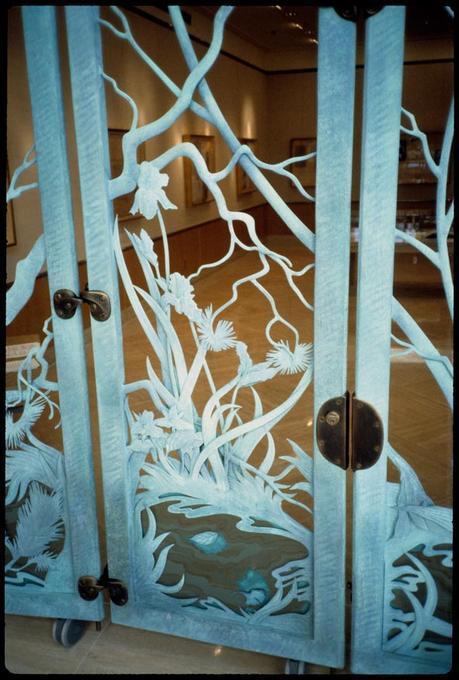Copper Screen Gates
- Title
-
Copper Screen Gates
- LC Subject
-
Architecture--Details
Art metal-work
Bronze sculpture
Copperwork
Decoration and ornament, Architectural
Doorways
Sculpture
Steelwork
sculpture (visual work)
public sculpture
bronze (metal)
copper (metal)
glass (material)
steelwork (visual works)
- Creator
-
Chabre, Wayne
- Description
-
The gate panels depict a moment in time showing the life cycle of a forest scene in Oregon. Plant forms are representative of different parts of Oregon. A theme of birth through death is represented by an old half dead pine and a new sapling, spring flowers, and a stream flowing through to provide nourishment. (information from OAC documentation)
Wayne Chabre; Interior Gates; Archives
waynechabre@charter.net
The Oregon Arts Commission has ten Regional Arts Councils that provide delivery of art services and information. The Council for this location is: Mid-Valley Arts. You may view their website at: http://www.oregonlink.com/arts/index.html
- View
-
detail
- Location
-
Oregon State Archives >> Marion County >> Oregon >> United States
Marion County >> Oregon >> United States
- Street Address
-
800 Summer St. N. E., Salem Oregon
- Award Date
-
1991
- Identifier
-
1991_salem_or-state-arch-bldg_03_a11
- Accession Number
-
1991_salem_or-state-arch-bldg_03_a11
- Rights
-
In Copyright
- Dc Rights Holder
-
Chabre, Wayne
- Type
-
Image
- Format
-
image/jpeg
- Measurements
-
10 feet 9 inches x7 feet 5 inches x 13/4 inches
- Material
-
Architecture; Sculpture; Metalwork
steel; copper; bronze and glass
- Set
-
Oregon Percent for Art
- Primary Set
-
Oregon Percent for Art
- Relation
-
1991 Oregon State Archives Building, Salem Oregon
1991_salem_or-state-arch-bldg
- Has Version
-
slide; color
- Institution
-
Oregon Arts Commission
University of Oregon
- Note
-
An online tour of art in the State Archives Building is available at http://arcweb.sos.state.or.us/tour/lobbyart.html
Entry to the exhibit gallery
- Color Space
-
RGB
- Biographical Information
-
These gates were designed to contrast with the architecture and complement the function of the building in which they are places. Through the use of ancient vegetative life-cycle symbolism and water as nourisher and sustainer of life, I've tried to connect the recorded lives in the Archives with the natural surroundings that nurtured them and without which the current cycles would not be possible. (Chabre, 1991)
